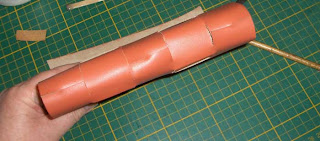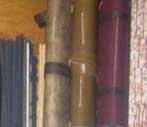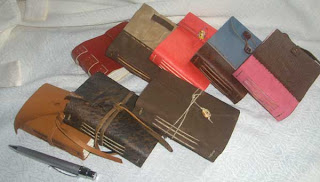So, as far as I know, all machine-made papers have a grain direction. This applies to standard printer paper, cardstock, drawing paper, watercolour paper, etc, as well as binder's board or other boards. Basically every paper material that we use for making books – except handmade paper. Though, even with handmade paper, I usually check it.
So the grain is a result of the way the fibers align during the paper making process. With handmade paper, the fibers are all over the place so grain doesn't form the same way. Machine-made paper will have the fibers all aligned in the same direction. Sometimes if you have some classic laid paper or other nice paper, you can see the lines. The lines that are really close together are across the grain – then the perpendicular lines that are spaced further apart, those are parallel to the grain. But most of the time, you can't see any of those lines.
I just scanned the web and found an article about paper grain by Richard P Grant, which looks very informative and quite detailed: About Paper Grain.
It is important to be aware of the paper's grain direction so that your books close properly, and so they will open properly, and so the spine will keep its shape, and so the boards don't warp, etc, I'm sure there are many many more reasons.
The direction of the paper grain should always always always be parallel to the spine of the book.
So the first part of my tutorial will focus on how to determine the grain direction of a piece of paper. I've never met a paper that I couldn't figure out.
Test 1
I always start with this test and it usually works. Just lightly bend the paper over and push down a little bit on the curved fold – without actually making a crease. Then lightly fold it the other way and press on it. Whichever direction presents the least resistance when you press lightly on the curved fold, then that is the grain direction. In these photos, I’m using standard 8.5" x 11" printer paper. It is always grain long – so when I bend it the long way (photo on the right), it is very easy to bend and there is much less resistance compared to when I tried it the other way.

Test 2
If Test 1 doesn't tell you for sure, let the paper hang over the edge of the table. Place the paper at the edge of the table, about half on and half off. Look to see how much angle there is where the paper bends. Then turn the paper around and do it again. Whichever direction has the most bend to it, then that is the direction of the grain.
In this photo, the paper in the foreground is bending along the grain. The paper in the background is bending across the grain so it doesn’t flop over the edge of the table as much. This was difficult to photograph but sometimes the difference is quite dramatic so if you try it, it can be quite obvious which direction is along the grain.

Test 3
This test requires that you destroy the paper, but it is quite reliable. Simply try to tear the paper straight down the middle. If it tears in a relatively straight line, then the tear is parallel with the grain - shown here by the black arrow. If you get a curved tear, or it is just impossible to go straight when you rip the paper, then you are tearing across the grain.

Test 4
If all else fails, I lick the paper. Cut off a corner and note its orientation. I mark the long and short direction on it usually. Then just lick it, and place it on the table. (You don't have to lick it, just dampen it lightly somehow). When it is damp, it will curl. The valley of the curl will be parallel to the grain direction, shown here by the black arrow. The key with this test is to remember how this little corner fits back onto your larger sheet of paper, otherwise the test isn't very helpful!

I have created two book blocks that are the same size, but one has the paper grain intentionally going the wrong way.

I have bound both of these book blocks because I was hoping to show how much incredibly better the 'good grain' book functions. The pages just lay so nicely in comparison to the book with the bad grain. Oh, just look at the beautiful open-book-shape of the good-grain book here. Other book…not so beautiful.

One thing that I really like is the fanning of a book's pages. Having the grain direction going the wrong way just devastates this wonderful feature of a book – it is more likely to just spurt in chunks rather than perform a lovely fluttering fan.

I made a brief video of this fanning process to more effectively show the difference. So in this clip, the bad sputtering book is shown first, followed by the nicely flowing fanning book.
I haven't been doing many hardcover books lately so when it comes to paper grain, my primary concern is with the book block; however, the paper grain factor just grows and grows when a hard cover is introduced.
I am not working on any hardcover books right now so I don’t have photos for this next part, but let me try to explain why it is important to be aware of the grain direction when making a hardcover book, and how it can be very useful too.
Binder's board can be tested for grain direction by just trying to bend it, so you can feel which way bends easiest. Or if you have a really big sheet of board, laying it half on and half off the table and checking to see how much it bends over the edge of the table will work too (like test 2 described above).
The grain direction of the binder’s board needs to be parallel to the spine, just like the grain direction of the book block. It is important to make sure that the grain direction of your covering paper is also parallel to the spine.
Papers expand when they are wet, and they usually expand more across the grain. So if you spread paste onto a piece of decorative paper, it will be slightly larger after it absorbs the moisture of the paste. This expansion will be most noticeable across the grain. So when you put this wet paper onto the binder's board, then let the paper dry, the paper shrinks back to its original size…pulling the edges of the binder's board with it as it shrinks…causing the warp. Now if you apply paste to another piece of decorative paper and adhere it to the other side of the binder's board and let it dry, when that second piece of paper shrinks back to its original size, it will pull the board in the opposite direction and make the whole thing flat again. No need to press while drying!
But this will only work if the board and both pieces of paper all have the grain directions parallel. Also, it will be most effective if the two pieces of decorative paper are the same kind of paper, so that they react the same and expand the same amount when damp. If the two pieces of paper are quite different in weight or density, then one piece might expand a lot more than the other thus not pulling the board back perfectly flat while drying.
If the papers are not the same, then the boards should be pressed while drying, but even pressing boards will not guarantee that they won’t warp now or at some point in the future.
Keep the grains parallel to the spine all the time, always. Your book will open better. The pages will fan nicely and lie open flat. The covers will dry flat. The spine will be stronger and less stressed. The entire book will be more cohesive. The book will have a longer life.
I sure hope that this makes sense to anybody who is trying to learn about paper grain. Or for anybody that already knows about this stuff, please let me know if I haven’t presented it clearly.
Now, I have to go dismantle the bad-grain book block that I made for this post...
















